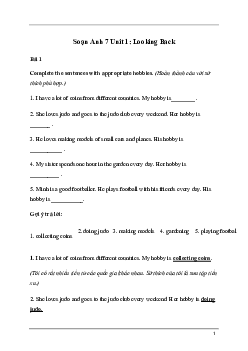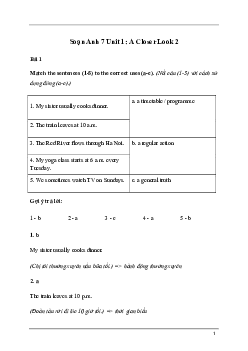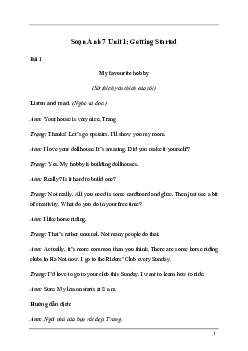



Preview text:
Ngữ pháp Tiếng Anh lớp 7 Unit 1 Hobbies
I. Thì hiện tại đơn - Present simple 1. Cách dùng
- Dùng để diễn tả thói quen hoặc những việc thường xuyên xảy ra ở hiện tại.
- Dùng để diễn tả những sự vật, sự việc xảy ra mang tính chất quy luật.
- Dùng để diễn tả các sự thật hiển nhiên, một chân lý, các phong tục tập quán, các hiện tượng tự nhiên.
- Dùng để diễn tả lịch trình cố định của tàu, xe, máy bay,…
2. Cấu tạo của thì hiện tại đơn
a. Với động từ tobe - Câu khẳng định: S + is/ are/ am + N/ Adj - Câu phủ định:
S + isn’t/ aren’t/ am not + N/ Adj - Câu nghi vấn: Is/ Are/ Am + S + N/ Adj? Yes, S + is/ are/ am
No, S + isn’t/ aren’t/ am not
b. Với động từ thường - Câu khẳng định S + Vs/ es - Câu phủ định S + don’t/ doesn’t + V - Câu nghi vấn Do/ Does + S + V? Yes, S do/ does No, S + don’t/ doesn’t
3. Dấu hiệu nhận biết
a. Nhóm trạng từ đứng ở trong câu
- Always (luôn luôn), usually (thường thường), often (thường), sometimes (thỉnh thoảng),
rarely (hiếm khi), seldom (hiếm khi), frequently (thường xuyên), hardly (hiếm khi), never
(không bao giờ), regularly (thường xuyên)…
- Các trạng từ này thường đứng trước động từ thường, sau động từ “to be” và trợ động từ.
b. Nhóm trạng ngữ đứng cuối câu
-Everyday/week/month/ year (hàng ngày/hàng tháng/hàng tuần/hàng năm)
-Once (một lần), twice (hai lần), three times (ba lần), four times (bốn lần)…
* Lưu ý: từ ba lần trở lên ta sử dụng: số đếm + times
4. Cách thêm s/es vào sau động từ
Trong câu ở thì hiện tại đơn, nếu chủ ngữ là ngôi thứ ba số ít (she,he,it,danh từ số ít) thì
động từ phải thêm đuôi s/es. Dưới đây là các quy tắc khi chia động từ.
- Thêm “s” vào đằng sau hầu hết các động từ
- Thêm “es” vào các động từ kết thúc bằng “ch,sh,x,s,z,o”
- Đối với động từ tận cùng bằng “y”
+ Nếu trước “y” là một nguyên âm (u,e,o,a,i) ta nguyên “y + s”
+ Nếu trước “y” là một phụ âm ta đổi “y” thành “I + es”
II. Bài tập vận dụng lý thuyết Unit 1 lớp 7 Global Success
Turn the following sentences into positive, nagative and interroagtive
1. (+) I like collecting glass bottles
(-) _____________________________________
(?) _____________________________________
2. (+) ___________________________________
(-) She doesn’t like taking photos.
(?) ____________________________________
3. (+) My sister enjoys going to the cinema with her friends.
(-) _____________________________________
(?) _____________________________________
4. (+) ___________________________________
(-) My favourite hobby isn’t watching the goldfish in the tank.
(?) _____________________________________
5. (+) ___________________________________
(-) _____________________________________
(?) Does John love being outdoors and discovering nature? Đáp án
1. (-) I don’t like collecting glass bottles
(?) Do you like collecting glass bottles?
2. (+) She likes taking photos
(?) Does she like taking photos?
3. (-) My sister doesn’t enjoy going to the cinema with her friends
(?) Does your sister enjoy going to the cinema with her friends?
4. (+) My favourite hobby is watching the goldfish in the tank
(?) Is your favorite hobby waching the goldfish in the tank?
5. (+) John loves being ourdoors and discovering nature
(-) John doesn’t love being outdoors and discovering nature
Write “do not” or “does not” to complete the sentences 1. I ....... prefer coffee.
2. She ....... ride a bike to her office.
3.Their friends ....... live in a small house.
4. They ....... do the homework on weekends.
5. Mike ....... play soccer in the afternoons.
6. The bus ....... arrive at 8.30 a.m.
7. We ....... go to bed at midnight.
8. My brother ....... finish work at 8 p.m. Đáp án
1. I ....do not... prefer coffee.
2. She ....does not... ride a bike to her office.
3.Their friends ...do not.... live in a small house.
4. They ..do not..... do the homework on weekends.
5. Mike ....does not... play soccer in the afternoons.
6. The bus ...does not.... arrive at 8.30 a.m.
7. We ...do not.... go to bed at midnight.
8. My brother .....does not.. finish work at 8 p.m.
Complete the sentences with do or does
1. Who __________ you play sport with?
2. What __________ James collect?
3. Where __________ Mike and Sam go shopping?
4. __________ she use her mobile phone a lot?
5. When __________ we finish school?
6. __________ Linda spend a lot of time watching TV? Đáp án
1. Who _____do_____ you play sport with?
2. What _____does_____ James collect?
3. Where _____do_____ Mike and Sam go shopping?
4. _____Does_____ she use her mobile phone a lot?
5. When ____do______ we finish school?
6. ___Does_______ Linda spend a lot of time watching TV?




